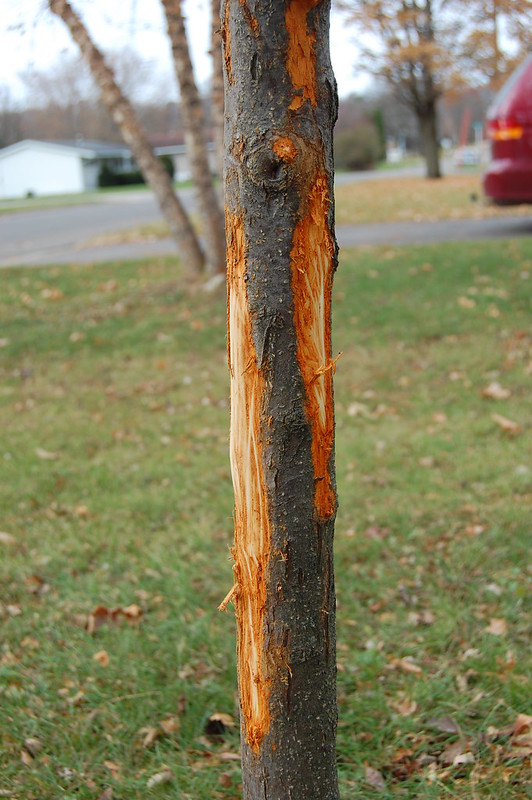Understanding Deer Damage to Trees and Effective Preventative Strategies
As the brisk winds of autumn sweep through Western New York, signaling the transition from summer to fall, it's important for us to address a prevalent concern for trees and shrubs in our region: deer damage. With the changing weather and the natural rhythms of wildlife, deer become more active, posing an unintentional threat to our beloved trees and shrubs. We are here to help you understand deer behavior and effective prevention strategies to safeguard your trees and shrubs during this time.
As temperatures cool and foliage shifts, deer begin to forage more actively. In Western New York, where deer populations thrive, trees and shrubs become prime targets for their feeding habits. They're particularly drawn to species such as arborvitae, yews, and fruit trees like apple and cherry. They like seeking out tender shoots, new growth, and foliage. Their browsing habits intensify during the early morning and late afternoon hours. Deer damage often presents as ragged or torn foliage, stripped bark, or broken branches. Male deer can also cause damage to trees by rubbing their antlers against the trunk, which can result in peeling or removal of the protective bark layers. The damage not only affects the aesthetic appeal of your trees and shrubs but can also compromise their structural integrity, leaving them vulnerable to disease and pest infestations.
Bark rub on a young tree. Younger trees may have a harder time recovering from deer damage.

.
A row of young maples have been painted with a deer deterrent to prevent buck rub. Some of these trees had bark rub damage from the previous year
Ethical mitigation of deer damage can be done in serveral ways. Installing fences or netting around vulnerable plants can act as effective physical barriers. Additionally, incorporating noise machines or decoys can create a sense of unease for deer, dissuading them from lingering in your yard. By disrupting their feeding patterns and creating an environment they perceive as inhospitable, you can significantly reduce the risk of damage to your trees and shrubs.
The spruce, left, has been hit hard by deer damage. The client has chosen to protect these newly planted arborvitae, right, with a foliar deer repellent to keep them full and healthy!
When nets and fences are not enough, or the area is too large to protect with fencing, our Plant Health Care team can assist. Our deer protection program uses foliar applications to create a barrier that deters deer from browsing on shoots and leaves. Similarly, bark paintings are applied to the trunk and lower limbs, emitting odors that deer find unappealing. By utilizing foliar sprays or bark paintings that contain repellent agents, you can bolster the resilience of your trees and minimize the risk of deer grazing and rubbing.
By understanding deer behavior, implementing preventative measures, and integrating PHC practices, you can ensure the health and vitality of your landscape. Remember, proactive care is the key to preserving the beauty and longevity of your greenery, even amidst the challenges posed by coexisting with wildlife. |
Ask the Arborist
Mike T.
Operations Manager & Climbing Arborist
Certified Tree Safety Professional

Q: Fall is coming which means leaves are falling. Should I rake my leaves?
A: Generally speaking, leaving leaves is beneficial for trees. They provide food for microbes, leading to increased soil health and biodiversity; they can provide an insulating layer protecting surface roots from cold winter temperatures, and through decomposition will return nutrients to the soil for the tree to use again the following spring. However, there are some instances, like with maple tar spot, where the fungi will overwinter on fallen leaves and reinfect the tree in spring. These fallen leaves should be removed.
Q: How can leaves contribute to soil health?
A: Fallen leaves contribute surface area for microbes and fungi to colonize, provide an additional food source for decomposers like worms and insects, return nutrients to the soil, and, like mulch, increase the soil's porosity while reducing the number of non-beneficial weeds. All of these benefits are advantageous to trees and the landscape.
Q: What else can I do with leaves?
A: Fun projects with children, like pressing leaves in books, can be a fun family activity; the use of leaf mulch to protect cold-sensitive plants from frost/cold damage is another option. Fallen leaves can even be bagged up and stacked along the wall of a house for a room that gets exceptionally cold in the winter as an added layer of insulation. As always, mulching in place and composting are also great options.
.png)

.jpg)
.jpg)

